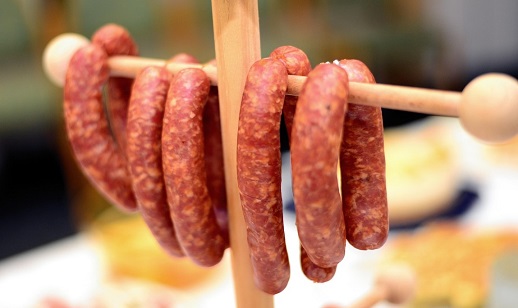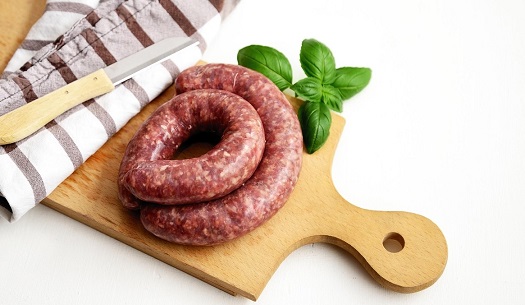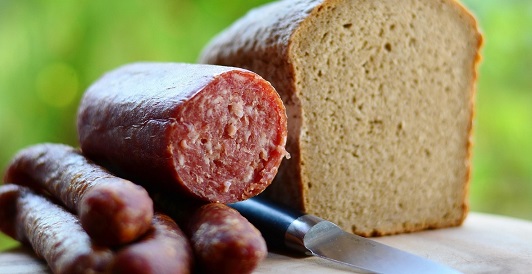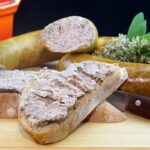
Germany has no shortage of raw meat delicacies, and Mettwurst is one of its finest – a cured, sometimes smoked, raw pork sausage eaten sliced or spread. Its intense flavor, deep color, and smooth or chunky texture make it a versatile snack, spread, or sandwich filling, depending on the region and variety.
Unlike Mett (fresh raw pork), Mettwurst is preserved through curing and smoking, giving it a longer shelf life and a safe, ready-to-eat status. If you’re intrigued by raw-cured meats like salami or Spanish chorizo, Mettwurst might just be your next favorite German sausage.
In this article, you’ll discover how Mettwurst is made, its many regional forms, and the best ways to serve and enjoy it safely.
What Is Mettwurst?
Mettwurst is a raw-cured and often smoked pork sausage, sometimes blended with beef or bacon. Its name comes from Mett, meaning finely minced pork, and Wurst, meaning sausage.
Unlike fresh Mett (which must be eaten the same day), Mettwurst undergoes:
- Curing with salt and nitrites
- Drying or cold-smoking
- Sometimes fermentation for tanginess
This makes it safe to eat uncooked and gives it a strong, savory flavor with a rich, reddish color.
Ingredients and Flavor Profile
Basic Ingredients:
- Pork (and sometimes beef or bacon)
- Salt
- Curing salt (with sodium nitrite)
- White and black pepper
- Paprika
- Nutmeg or mace
- Garlic
- Optional: caraway, coriander, marjoram
Texture varies by region:
- Soft Mettwurst: spreadable, like a pâté or thick paste
- Firm Mettwurst: dry and sliceable, like salami
The smoking and drying process creates a savory, tangy, and slightly smoky flavor.
(For comparison with fresh Mett, see Mett vs. Hackepeter.)
Regional Varieties of Mettwurst

1. Northern Germany (Spreadable Mettwurst)
- Soft, often sold in plastic tubes or jars
- Commonly spread on bread with mustard or pickles
- Very popular in Hamburg and Lower Saxony

2. Southern Germany (Hard Mettwurst)
- Firmer texture, similar to salami
- Thinly sliced as part of a cold cuts platter (Brotzeit)
- Includes smoked or dry-aged types
3. Thüringer Mettwurst
- Medium firmness
- Coarsely ground with a smoky, rustic flavor
- Often includes beef or bacon
4. Braunschweiger Mettwurst
- Soft, smoked, and very garlicky
- Also popular in parts of the U.S. as a spreadable liverwurst variant
Each region adds its own twist to the spice blend, smoking process, and texture.
How Is Mettwurst Made?
Making Mettwurst is a careful process that blends traditional meat preservation techniques – curing, fermentation, and smoking – with precise control over hygiene and air conditions. It differs significantly depending on whether the end product is a soft, spreadable sausage or a firm, sliceable one.
Below is a detailed step-by-step process for producing raw-cured Mettwurst, focusing on safety and authenticity.
Step-by-Step Production: Traditional Method
1. Select High-Quality Meat and Fat
- Use lean pork shoulder or leg meat, trimmed of sinew.
- Combine with pork fatback or belly in a ratio of roughly 70% lean meat to 30% fat.
- In some regional varieties, beef or bacon is added for a stronger flavor.
- All meat must be very fresh, and the equipment thoroughly sanitized.
2. Grind the Meat
- For firm Mettwurst: Grind meat and fat through a coarse plate (4-6 mm).
- For spreadable Mettwurst: Use a finer plate (2-3 mm) or grind twice for a smooth, emulsified texture.
- Chill the mixture immediately after grinding to maintain food safety.
3. Add Cure and Spices
- Mix the meat with:
- Curing salt (Pökelsalz or Prague Powder #1) – typically 2.5-3% of the total meat weight.
- Sea salt, white/black pepper, paprika, garlic, and marjoram, depending on the regional style.
- Optional additions: nutmeg, mustard seed, caraway, or starter cultures for fermentation.
4. Mix and Bind the Sausage
- Knead or paddle the mixture thoroughly by hand or machine until it becomes tacky and cohesive.
- This step ensures the fat and proteins bind well and the seasoning is evenly distributed.
5. Stuff into Natural Casings
- Use pork or beef casings, depending on the diameter and firmness desired.
- Soft Mettwurst: thinner casings (32-36 mm).
- Hard Mettwurst: larger casings (up to 50 mm).
- Stuff tightly and avoid air pockets.
- Twist or tie into manageable links or leave as long coils for hanging.
6. Cold Smoke or Air-Dry
- For smoked Mettwurst:
- Hang in a smokehouse or chamber at 15-25°C (59-77°F).
- Cold smoke with beechwood or alder for several hours each day, over 1–3 days depending on intensity desired.
- For unsmoked/dry Mettwurst:
- Place in a curing chamber at 10-15°C (50-59°F) with 75-80% humidity.
- Allow to dry and ferment slowly.
7. Ripening and Maturation
- Let sausages ripen in a controlled environment for 7 to 21 days, depending on size and desired firmness.
- During this period:
- Moisture is lost.
- Flavor develops through enzymatic action.
- pH drops slightly due to lactic fermentation (if starter culture used), enhancing shelf stability.
The sausage is considered ready when it:
- Feels firm to the touch (for hard types).
- Has developed a reddish interior, indicating full cure.
- Has a rich, tangy aroma without sourness or spoilage notes.
How to Eat Mettwurst
Soft Mettwurst:
- Spread on rye bread, dark rolls, or crackers
- Pair with onion, gherkins, or mustard
- Common in school lunches or office snacks
Firm Mettwurst:
- Slice thinly and serve with:
- Brotzeit platters
- Cheese boards
- Pickled vegetables
- Add to:
- Hearty soups
- Scrambled eggs
- Savory pastries or rolls
Beverage Pairings:
- Pilsner or dark beer
- Schnapps (if you’re going full traditional)
- Buttermilk or apple juice for milder pairings
Safety and Storage
Unlike fresh Mett, Mettwurst is preserved and ready to eat out of the package, provided it’s:
- Properly cured
- Kept refrigerated
- Consumed before expiration
Storage Tips:
- Soft Mettwurst: 7-10 days refrigerated after opening
- Hard Mettwurst: 2-3 weeks refrigerated
- Can be frozen (though texture may change)
Always follow packaging instructions and buy from trusted butchers or brands.
Nutritional Notes
- High in protein and flavor
- Moderate to high fat content, especially spreadable types
- Some versions contain nitrates, salt, and preservatives due to the curing process
It’s a rich, satisfying treat – best enjoyed in moderation.
Mettwurst Fun Facts
- In Cologne and Bonn, Mettwurst is a staple in Carnival season sandwiches
- In Australia, “Mettwurst” often refers to a semi-dry sausage eaten sliced with cheese
- In northern Germany, some people stir soft Mettwurst into warm mashed potatoes
- Mettwurst is sometimes gifted in holiday food baskets, especially hard-cured types
From smoky slices to creamy spreads, Mettwurst offers something for every sausage lover. With its cured richness and regional charm, it represents Germany’s dedication to meat preservation, craftsmanship, and bold flavor.
Whether you try it spread on rye bread or sliced alongside cheese and pickles, this raw-cured sausage is a uniquely German delicacy that deserves a place on any cold plate.
Curious how it compares to fresh Mett? Read Mett vs. Hackepeter or explore Blutwurst for another deep dive into raw meat tradition.
Related Articles:
12 Types of German Wurst You Should Know
From Bratwurst to Blutwurst, this guide introduces 12 of Germany’s most iconic sausages. Learn what makes each one unique – and how to cook or serve them.
What Is Landjäger? Germany’s Hiking Sausage Explained
Find out why Landjäger is Germany’s go-to snack for hikers. Learn how it’s made, how to store it, and what makes it perfect for outdoor adventures.
What Is Knackwurst? Germany’s Snappy Sausage Explained
Learn all about Knackwurst – the garlicky, juicy sausage that snaps when you bite. See how it’s made and served across Germany.
What Is Bockwurst? Mild German Sausage Explained
Bockwurst is Germany’s mild, family-friendly sausage. Find out why it’s beloved by all ages and how to poach and serve it the right way.
What Is Blutwurst? Traditional German Blood Sausage
Blutwurst is Germany’s traditional blood sausage – rich, hearty, and historic. Learn how it’s made, regional styles, and how to cook or enjoy it cold.
Nürnberger Rostbratwurst – Recipe and History
Explore the legacy of Nürnberger Rostbratwurst – the small sausage with big flavor. Includes authentic preparation methods and cultural background.
The Best Homemade Currywurst Recipe
Make authentic Berlin-style Currywurst at home with this easy recipe. Includes sausage prep, homemade curry ketchup, and street food-style serving tips.
Frankfurter Würstchen – The Original German Hot Dog
Discover the authentic Frankfurter Würstchen – Germany’s original hot dog. Learn its history, protected status, and how to heat and serve it the traditional way.
Teewurst – Soft German Sausage for Spreading
Explore Teewurst, the smoky, spreadable sausage originally served at tea time. Find out how it’s made, stored, and delicious ways to enjoy it at home.
How to Make Traditional German Bratwurst at Home
This detailed recipe guide walks you through making real German Bratwurst from scratch – with tips on ingredients, grinding, stuffing, and grilling.







